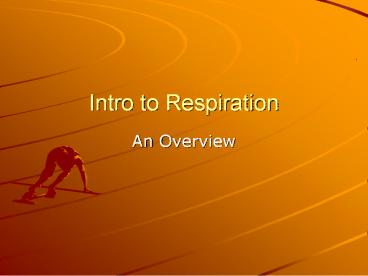Intro to Respiration - PowerPoint PPT Presentation
1 / 23
Title:
Intro to Respiration
Description:
Title: Cellular Respiration Author: Smuts Family Last modified by: Williams, Maria Created Date: 10/25/2005 1:14:33 PM Document presentation format – PowerPoint PPT presentation
Number of Views:95
Avg rating:3.0/5.0
Title: Intro to Respiration
1
Intro to Respiration
- An Overview
2
What are we learning?
- Why is it important?
3
Learning Intention
- Understand how energy is transformed in the cell
to useable forms
4
Cellular Respiration Releases energy by
breaking down glucose and other food molecules in
the presence of oxygen.
- 6O2 C6H12O6 6CO2 6H2O Energy
- Is anything about this equation familiar???
5
Almost Everything we need to know is in this
organizer!!!
6
In which organelle does Cellular Respiration take
place?
- The Mitochondria
7
In which organisms does cellular respiration take
place?
- Plants
- Animals
- Both plants
- and animals
8
The steps of Aerobic Respiration
- What does Aerobic mean?
- In the presence of Oxygen
- 3 steps
- 1. Glycolysis (doesnt require O2)
- 2. Krebs Cycle
- 3. Electron Transport Chain
9
(No Transcript)
10
Glycolysis
- Glucose (A six carbon sugar) is broken down into
two 3-carbon pyruvic acid molecules. - Requires two ATP molecules.
- Creates 4 ATP molecules and 2 NADPH molecules for
the electron transport chain.
What is the net ATP production during Glycolysis?
11
- In the presence of oxygen
- Pyruvic acid (3 Carbon) from glycolysis is
further decomposed to Acetyl coA (2 Carbon
molecule) - Krebs Cycle
- Acetyl CoA is converted to CO2, and NADH, ATP,
and FADH2 are recharged. - Occurs in the mitochondria.
- The end energy tally from 1 Glucose (2 pyruvic
acids) is - 6 NADH
- 2 FADH2
- 2 ATP
12
What is the main product of the Krebs Cycle that
comes from the complete breakdown of glucose ?
13
(No Transcript)
14
Electron Transport
- The Krebs Cycle creates high energy electrons.
- These electrons are passed along a series of
proteins in the mitochondrial membrane. - The electrons from the 6 NADH are used to form 18
ATP molecules. - The electrons from the 2 FADH2 are used to make 2
ATP molecules.
15
(No Transcript)
16
One Glucose molecule produces 36 ATP through the
process of Cellular Respiration!!!
17
What if no oxygen is present????
18
Fermentation
- An anaerobic respiration meaning that oxygen is
not required. - Two types of fermentation
- Alcoholic Fermentation
- Lactic Acid Fermentation
19
Alcoholic Fermentation
- Used by yeast and a few other microorganisms.
- Produces Ethyl Alcohol and CO2 as wastes.
- Pyruvic Acid NADH
- Alcohol CO2 NAD
20
Lactic Acid Fermentation
- Produced in many cells including your muscles.
- Pyruvic Acid NADH
- Lactic Acid NAD
- Lactic Acid is produced during rapid exercise,
causing a painful, burning sensation. This
effect is reduced with potassium.
21
Cellular Respiration of Glucose Molecule.
- Glycolysis 6 ATP
- Krebs Cycle and Electron Transport Chain 30 ATP
- Grand Total of 36 ATP molecules from 1 Glucose!
22
Energy and Exercise
- Quick Energy comes from ATP in the muscle cell
ready for use. - a few seconds
- Long Term Energy- cellular respiration provides
energy for at least 20-30 minutes. - Fermentation occurs more rapidly so it also kicks
in. - After 20-30 minutes, other molecules, such as
fats or proteins are used for energy.
23
Journal
- Explain the differences between aerobic and
anaerobic respiration?































